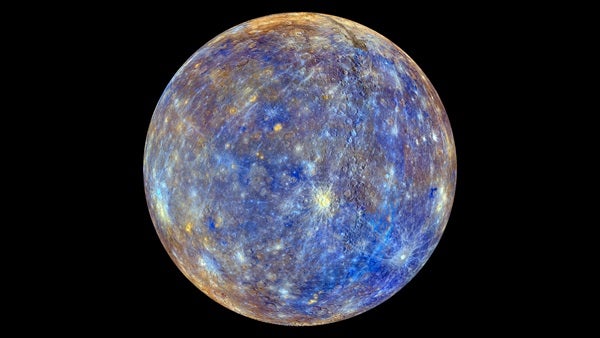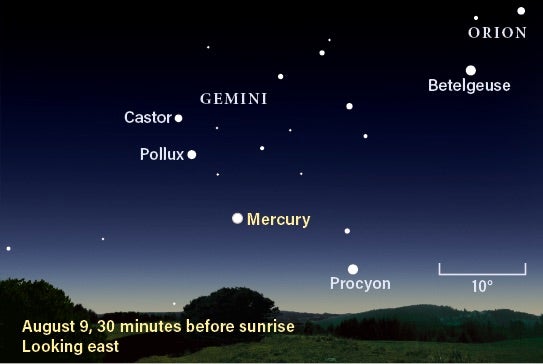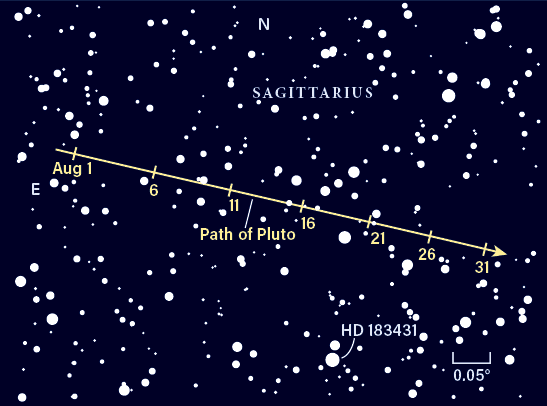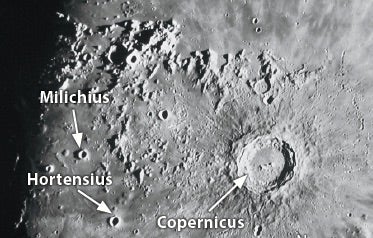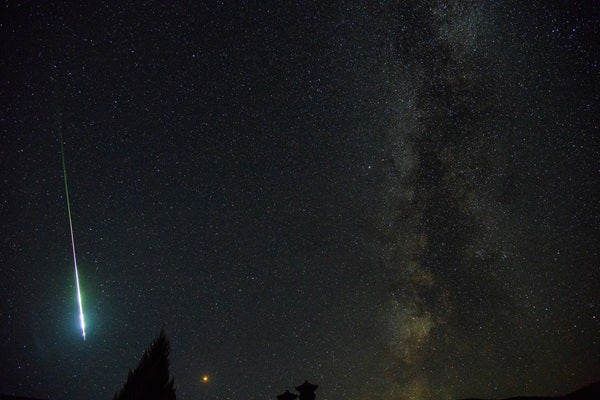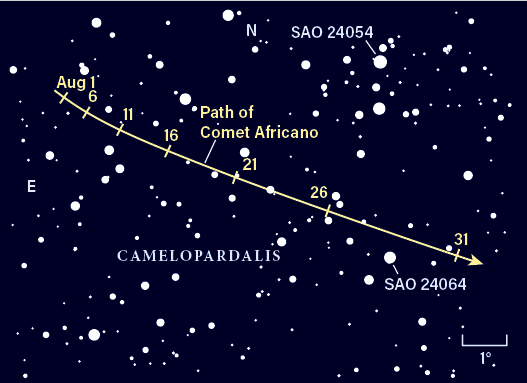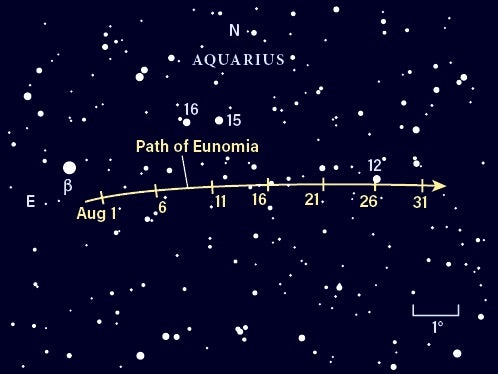As the sky darkens these August evenings, Jupiter commands your attention from its perch one-third of the way from the southern horizon to the zenith. You can find the giant world against the backdrop of southern Ophiuchus, above the more obvious stars of Scorpius. The Scorpion’s 1st-magnitude luminary, ruddy Antares, lies one binocular field southwest of Jupiter. But the star is really no competition: The planet shines at magnitude –2.3, some 20 times brighter than Antares. Only the Moon glows brighter on August nights. You can compare the two objects directly on the 9th, when our satellite passes 2° north of the planet.
Jupiter has been heading westward relative to the starry background since April, but that ends August 11 when it resumes its normal eastward course. From August 25–27, the planet skirts the edge of the 10th-magnitude globular cluster NGC 6235. Although Jupiter’s brilliance renders the cluster barely visible through most telescopes, imagers should be able to capture both.
A telescope also reveals stunning detail in Jupiter’s cloud tops. The giant planet’s disk spans 43″ August 1 and 39″ at month’s end. That’s large enough to show atmospheric features through small scopes, while finer aspects appear in larger scopes and during moments of steady seeing.
The easiest structures to see are two parallel dark belts, one on either side of a brighter zone that coincides with the planet’s equator. Dark, fingerlike features called barges appear in the belts, along with wispy festoons that extend into the Equatorial Zone. All three regions rotate with a period of 9 hours 50 minutes. The latitudes north and south of the belts rotate in 9 hours 55 minutes. The boundary region where clouds traveling at these different speeds meet are sites of great turbulence and always worth exploring.
The three inner moons also regularly cross in front of Jupiter, casting their dark shadows onto the planet’s cloud tops. Use the “Jupiter’s moons” graphic on the right side of page 41 to find the best nights to observe these dramatic transits. Outermost Callisto just misses the planet during the course of its orbital dance. You can find it south of the gas giant around midnight local daylight time the night of August 16/17.
Look 30° east of Jupiter and you’ll immediately spot Saturn. The ringed planet lies in northern Sagittarius and stands 25° high in the southeast as darkness descends. It gains a few degrees by the time it climbs highest in the south in late evening. Saturn shines at magnitude 0.2, four times brighter than any of the Archer’s stars.
The planet’s westward motion against the background stars continues during August. This trek carries it 0.6° due south of the 4th-magnitude star Omicron (ο) Sagittarii the night of August 7/8. Four nights later, a waxing gibbous Moon appears 3° west of Saturn.
Most observers don’t spend lots of time viewing the planet’s bland disk. Although it has belts and zones like Jupiter, high-level haze in its atmosphere makes them hard to pick out under less-than-perfect conditions. Careful observers also may notice that the north polar region appears a dusky gray compared with the yellowish temperate regions.
In stark contrast, the ring system shows plenty of details. Any scope reveals the dark Cassini Division that separates the outer A ring from the brighter B ring. The innermost C ring appears much dimmer than the other two.
Saturn’s family of moons covers a broader brightness range than Jupiter’s. Any telescope reveals 8th-magnitude Titan, the ringed planet’s biggest moon and the solar system’s second largest. A 4-inch telescope corrals three 10th-magnitude moons — Tethys, Dione, and Rhea — that circle Saturn inside Titan’s orbit. Outermost Iapetus, whose brightness varies markedly throughout its orbit, is easiest to spot as an 11th-magnitude dot when it passes 1.4′ due north of the planet the night of August 4/5.
Although it lies just 6° east of Saturn, Pluto will test your observing skills. The dwarf planet glows at magnitude 14.2 and shows up as a pinprick of light through 8-inch or larger scopes on a dark night. The key is to have a go-to telescope or be able to star-hop from relatively bright (though still dim) stars with the help of the finder chart on the opposite page. The brightest star in Pluto’s vicinity this month is magnitude 9.4 HD 183431. Pluto passes 12′ due north of this star on the 18th. One night later, the distant world slides 2′ north of a magnitude 10.5 field star.
The early morning hours are the best for viewing Uranus. Although the planet rises before midnight local daylight time, it doesn’t climb highest in the south until near the break of dawn. Uranus shines at magnitude 5.8, bright enough to see with the naked eye under a dark sky but much easier to find through binoculars.
The ice giant resides in a sparse region of southern Aries, 11° south and a hair east of the Ram’s brightest star, 2nd-magnitude Hamal (Alpha [α] Arietis). Two magnitude 5.7 stars help blaze the way. Drop 4.0° south of Hamal to 15 Ari, then another 4.3° south to 19 Ari. Uranus lies 2.3° south-southeast of this final star. And because the planet reaches its stationary point the night of August 11/12, it doesn’t move much from this spot all month. A telescope reveals Uranus’ distinctive blue-green disk, which measures 3.6″ across.
Mercury enjoys a nice but brief appearance before dawn this month. The inner planet reaches greatest elongation August 9, when it lies 19° west of the Sun and rises 90 minutes before our star. It climbs 7° high in the east-northeast 45 minutes before sunrise. The magnitude 0.0 world shines noticeably brighter than the twin stars of Gemini, Castor and Pollux, which lie higher and point in Mercury’s direction. The planet becomes even easier to see as it brightens noticeably in the week that follows. On the 17th, it shines at magnitude –0.9 and appears 6° high 45 minutes before sunup. It soon drops out of sight, however, as it heads toward superior conjunction in early September.
It’s also worth taking a few minutes to target Mercury with your telescope. The best views come on the morning of greatest elongation, when the planet appears 8″ across and barely one-third lit. By August 17, its diameter has shrunk to 6″ and its phase has waxed to two-thirds lit.
Venus and Mars lie too close to the Sun to see during August. Both planets will return to view in October — Venus at dusk and Mars before dawn.
Rising Moon: The Sun lights up Luna’s low-lying hills
The Moon’s frozen face records the scars of its dual past life. Hefty asteroids have pelted the surface since the day it was born, and these collisions gouged out large craters and impact basins. Volcanism later released prodigious amounts of lava that flooded the basins and created some low-lying hills.
Copernicus is our gateway on this trip of lunar discovery. When the prominent crater lies on the terminator — the line separating darkness from light — its high walls stand out above the surrounding plain. Sunrise occurs over this complex region August 9. Explore the sunlit side of Copernicus, and you’ll see a textured surface that looks like the aftermath of a small rock landing in a mud puddle — secondary pits mark where blast remnants fell shortly after the main impact, and splattered material drapes the area.
By August 10, the Sun illuminates Copernicus’ western side, and the smaller crater Hortensius now rests on the terminator. Study the area north of Hortensius, and you’ll find a cluster of several volcanic domes. Each little bump sports its own shadow, but they appear only when the Sun hangs low in the lunar sky. Each dome is about 1,000 feet high and 4 miles wide. If the night is superb, a 6-inch or larger telescope might reveal a summit pit on some of these hills. Lunar scientists don’t know whether the domes were pushed up from below or built up gradually during relatively quiet, long-lived eruptions.
A few hours later, the Sun’s rays glance across another large dome just west of Milichius Crater. You could spend hours enjoying the play of light and shadow in the region around Copernicus. If you don’t get your fill on the 10th, wait until the Sun sets over this area the morning of August 24.
Meteor watch: Summer’s most prolific show takes a hit
A bright Moon seriously hinders the Perseid meteor shower this year. The shower’s peak occurs the morning of August 13, just two days before Full Moon. On the 13th, the Moon sets around 4 a.m. local daylight time, and the first hints of twilight fire up the eastern horizon barely 15 minutes later.
It’s still worth checking the skies in the hour or so before dawn, however, because the Perseids produce more of the extremely bright meteors known as fireballs than any other shower. For the best view, choose an otherwise dark site and position yourself so that a building or tree blocks your view of the Moon low in the southwest. You may see only a dozen or so “shooting stars” per hour, but that’s still a better rate than you’ll get with all but a handful of other meteor showers.
Another option is to observe a morning or two before the peak. The Perseids deliver roughly half their maximum rate a day from the peak and a quarter dose two days removed. But the Moon sets nearly an hour earlier on August 12 and two hours earlier on the 11th, providing a longer dark-sky window for meteor viewing.
Perseid meteors appear to radiate from a point in the constellation Perseus, which rises in early evening and climbs two-thirds of the way to the zenith as twilight starts to paint the sky.
Comet search: Roaming the northern Milky Way
Starting in September, the solar system will deliver a near-continuous stretch of 9th-magnitude or brighter comets that will last for more than a year. You can glimpse the first of these — Comet Africano (C/2018 W2) — as it brightens to 11th magnitude in August.
You’ll need to observe with a 10-inch or larger telescope under a dark sky to see this first-time visitor to the inner solar system. Even then, the comet appears as an indistinct glow in the obscure constellation Camelopardalis. Although the Giraffe remains visible all night, it climbs highest in the north in the early morning.
Africano lies in a fairly crowded field in the Milky Way. To get there, start at magnitude 1.8 Alpha (α) Persei and then swing 5.7° north to magnitude 5.1 SAO 24064. You should be able to star-hop from this modest star to the comet using the finder chart above.
Use magnifications of 150x or more to see Africano’s shape. You should notice that its southern flank appears more distinct because this is where sunlight and the solar wind push back on the dust and gas the comet’s nucleus releases.
Asteroid 15 Eunomia reaches opposition and peak visibility the night of August 12/13. It then traverses the sky from dusk until dawn and climbs halfway to the zenith in the southern sky around 1 a.m. local daylight time. Eunomia also shines brightest at opposition, reaching magnitude 8.2, though it remains above magnitude 8.5 all month. This places the asteroid within range of binoculars from rural areas and 4-inch scopes from the suburbs.
Eunomia sails westward across the starry seas of Aquarius the Water-bearer. And in a stroke of good luck, the asteroid begins August just a stone’s throw from the constellation’s brightest star, magnitude 2.9 Sadalsuud (Beta [β] Aquarii). On the 1st, Eunomia lies 1.0° southwest of Beta. It has an even closer encounter with 6th-magnitude 12 Aqr on the 26th, passing just 0.1° south of this star.
Because the background sky in this direction holds quite a few stars as bright as Eunomia, identifying it becomes a game of hide-and-seek. Use the chart to zero in on the right location and then make a quick sketch at the eyepiece of the four or five brightest stars. Return a night or two later to see which point has moved on and confirmed its solar system bona fides. You should be able to notice a position shift in just a few hours thanks to well-placed field stars between August 14 and 18.
Italian astronomer Annibale de Gasparis spotted Eunomia in 1851, 50 years after countryman Giuseppe Piazzi found the first asteroid, Ceres. Eunomia, named after a Greek goddess of order and law, was the fourth of nine asteroids de Gasparis discovered.

